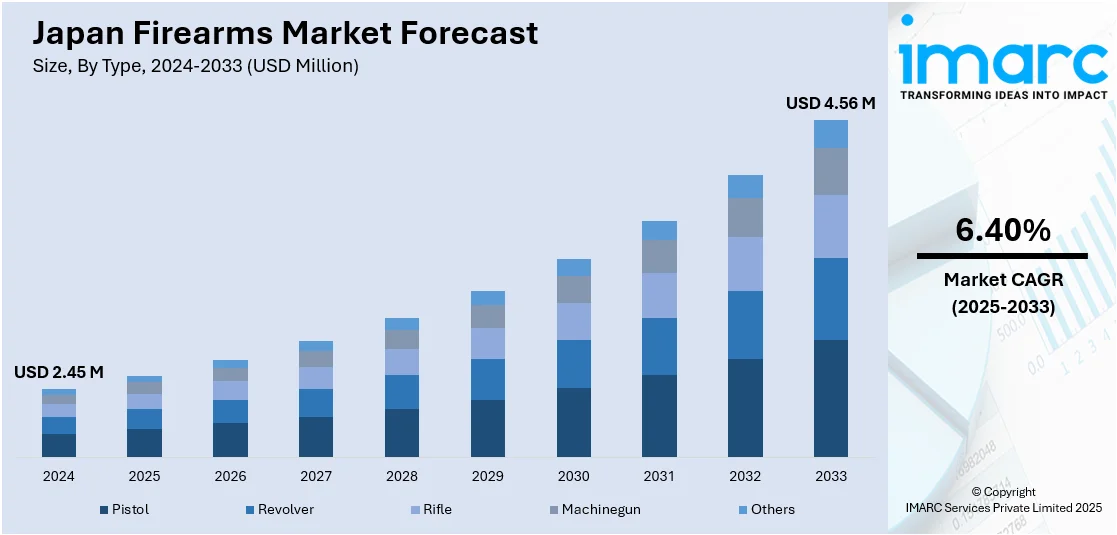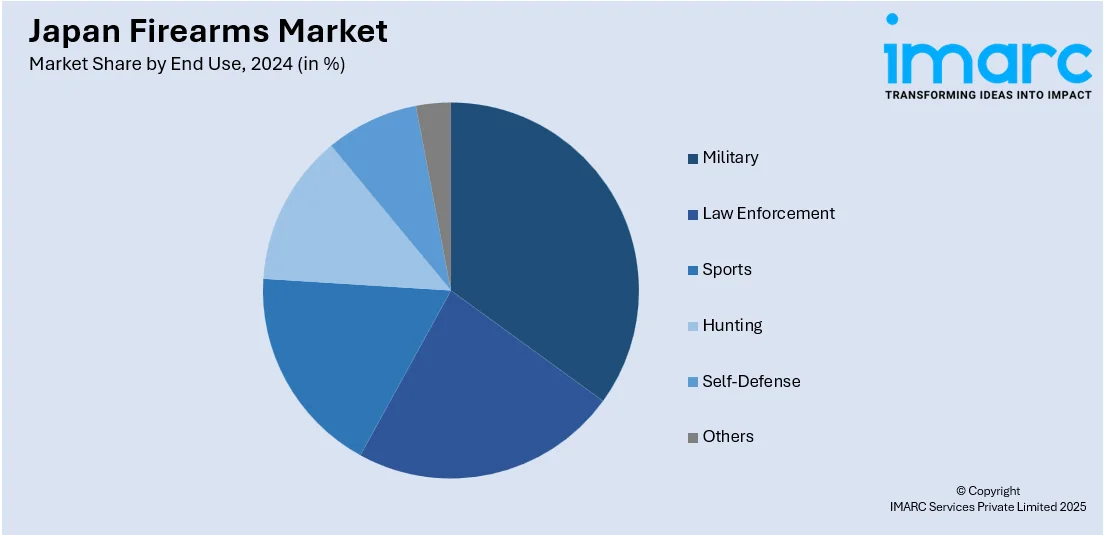
Japan Firearms Market Size, Share, Trends and Forecast by Type, Technology, Operation, End Use, and Region, 2025-2033
Japan Firearms Market Overview:
The Japan firearms market size reached USD 2.45 Million in 2024. Looking forward, IMARC Group expects the market to reach USD 4.56 Million by 2033, exhibiting a growth rate (CAGR) of 6.40% during 2025-2033. The market is driven by strict regulatory frameworks, cultural attitudes, and technological innovation. Stringent gun laws limit ownership to mainly hunting and sports, ensuring a highly regulated niche market. Culturally, firearms are stigmatized and associated with violence, suppressing general demand and promoting safety-first perspectives. Moreover, the ongoing technological advancements such as smart guns and enhanced safety features cater to enthusiasts and professionals, aligning with Japan’s legal and cultural priorities while sustaining innovation within the industry’s narrow scope thus impelling the Japan firearms market share.
|
Report Attribute
|
Key Statistics
|
|---|---|
|
Base Year
|
2024
|
|
Forecast Years
|
2025-2033
|
|
Historical Years
|
2019-2024
|
| Market Size in 2024 | USD 2.45 Million |
| Market Forecast in 2033 | USD 4.56 Million |
| Market Growth Rate 2025-2033 | 6.40% |
Japan Firearms Market Trends:
Cultural Attitudes Towards Firearms
Cultural factors profoundly impact Japan firearms market growth. Japanese society traditionally associates guns with crime and violence, resulting in widespread social stigma against gun ownership. Unlike in many Western countries where firearms may symbolize personal freedom or self-defense, in Japan, the emphasis is on public safety and social harmony. This cultural attitude drives low demand for firearms, making the market highly specialized. The focus lies primarily on hunting, sport shooting clubs, and collecting antique or historical weapons rather than self-defense. This social mindset supports strict regulations and low crime rates involving firearms, reinforcing the market’s controlled and limited nature. Manufacturers and retailers thus cater to enthusiasts who value firearms as sporting tools or cultural artifacts, rather than everyday necessities.

Strict Gun Control Laws and Regulations
Japan’s firearms market is shaped by some of the world’s strictest gun control laws under the Firearm and Sword Possession Control Law, which permits only limited firearm types mainly hunting rifles and shotguns under stringent licensing conditions. As of 2023, only 196,518 individuals held firearm licenses, equating to 0.16 per 100 people, with just 0.8% of households owning guns. These figures reflect the law’s impact in minimizing firearm circulation and curbing demand, confining the market to a niche of hunters, sport shooters, and collectors. Strict requirements, including background checks, mental health evaluations, and safety training, create high entry barriers and discourage casual ownership. Consequently, Japan’s firearms market remains small but stable, focused on compliance, safety, and controlled distribution. The regulatory environment also drives innovation in non-lethal and technologically advanced firearm alternatives, supporting a culture of responsible ownership and public safety over widespread access.
Technological Innovations in Firearms and Security Systems
Despite the small scale, technological advancement is a key driver shaping Japan’s firearms market. With strict regulations limiting gun types and usage, innovation often centers on improving safety, precision, and integration with advanced security technologies. Japanese manufacturers focus on enhancing firearm accuracy, reliability, and ergonomics for sport shooting and hunting purposes. Additionally, advancements in smart gun technology, such as biometric locks and electronic safety systems, align with Japan’s emphasis on preventing unauthorized use. The market also benefits from parallel developments in non-lethal weapons and security equipment that complement firearms regulations. These innovations not only meet legal requirements but also appeal to the niche market of responsible firearm users seeking cutting-edge, safe products. This continuous technological evolution keeps the industry competitive within its constraints.
Japan Firearms Market Segmentation:
IMARC Group provides an analysis of the key trends in each segment of the market, along with forecasts at the country and regional levels for 2025-2033. Our report has categorized the market based on type, technology, operation, and end use.
Type Insights:
- Pistol
- Revolver
- Rifle
- Machinegun
- Others
The report has provided a detailed breakup and analysis of the market based on the type. This includes pistol, revolver, rifle, machinegun, and others.
Technology Insights:
- Guided
- Unguided
A detailed breakup and analysis of the market based on the technology have also been provided in the report. This includes guided and unguided.
Operation Insights:
- Automatic
- Semi-Automatic
- Manual
The report has provided a detailed breakup and analysis of the market based on the operation. This includes automatic, semi-automatic, and manual.
End Use Insights:

- Military
- Law Enforcement
- Sports
- Hunting
- Self-Defense
- Others
A detailed breakup and analysis of the market based on the end use have also been provided in the report. This includes military, law enforcement, sports, hunting, self-defense, and others.
Regional Insights:
- Kanto Region
- Kansai/Kinki Region
- Central/ Chubu Region
- Kyushu-Okinawa Region
- Tohoku Region
- Chugoku Region
- Hokkaido Region
- Shikoku Region
The report has also provided a comprehensive analysis of all the major regional markets, which include Kanto Region, Kansai/Kinki Region, Central/ Chubu Region, Kyushu-Okinawa Region, Tohoku Region, Chugoku Region, Hokkaido Region, and Shikoku Region.
Competitive Landscape:
The market research report has also provided a comprehensive analysis of the competitive landscape. Competitive analysis such as market structure, key player positioning, top winning strategies, competitive dashboard, and company evaluation quadrant has been covered in the report. Also, detailed profiles of all major companies have been provided.
Japan Firearms Market News:
- In April 2025, Japan unveiled its latest electromagnetic railgun, developed by the Acquisition, Technology & Logistics Agency (ATLA) to counter hypersonic missiles. Resembling a sci-fi weapon, the railgun uses electromagnetic force to launch projectiles at extreme speeds without explosives. Since 2016, Japan has led global interest in railgun tech, investing ¥46.3 billion (US\$300 million) over three years. The system is designed for deployment by the Japan Maritime Self-Defense Force.
Japan Firearms Market Report Coverage:
| Report Features | Details |
|---|---|
| Base Year of the Analysis | 2024 |
| Historical Period | 2019-2024 |
| Forecast Period | 2025-2033 |
| Units | Million USD |
| Scope of the Report |
Exploration of Historical Trends and Market Outlook, Industry Catalysts and Challenges, Segment-Wise Historical and Future Market Assessment:
|
| Types Covered | Pistol, Revolver, Rifle, Machinegun, Others |
| Technologies Covered | Guided, Unguided |
| Operations Covered | Automatic, Semi-Automatic, Manual |
| End Uses Covered | Military, Law Enforcement, Sports, Hunting, Self-Defense, Others |
| Regions Covered | Kanto Region, Kansai/Kinki Region, Central/ Chubu Region, Kyushu-Okinawa Region, Tohoku Region, Chugoku Region, Hokkaido Region, Shikoku Region |
| Customization Scope | 10% Free Customization |
| Post-Sale Analyst Support | 10-12 Weeks |
| Delivery Format | PDF and Excel through Email (We can also provide the editable version of the report in PPT/Word format on special request) |
Key Questions Answered in This Report:
- How has the Japan firearms market performed so far and how will it perform in the coming years?
- What is the breakup of the Japan firearms market on the basis of type?
- What is the breakup of the Japan firearms market on the basis of technology?
- What is the breakup of the Japan firearms market on the basis of operation?
- What is the breakup of the Japan firearms market on the basis of end use?
- What is the breakup of the Japan firearms market on the basis of region?
- What are the various stages in the value chain of the Japan firearms market?
- What are the key driving factors and challenges in the Japan firearms market?
- What is the structure of the Japan firearms market and who are the key players?
- What is the degree of competition in the Japan firearms market?
Key Benefits for Stakeholders:
- IMARC’s industry report offers a comprehensive quantitative analysis of various market segments, historical and current market trends, market forecasts, and dynamics of the Japan firearms market from 2019-2033.
- The research report provides the latest information on the market drivers, challenges, and opportunities in the Japan firearms market.
- Porter's five forces analysis assist stakeholders in assessing the impact of new entrants, competitive rivalry, supplier power, buyer power, and the threat of substitution. It helps stakeholders to analyze the level of competition within the Japan firearms industry and its attractiveness.
- Competitive landscape allows stakeholders to understand their competitive environment and provides an insight into the current positions of key players in the market.
Need more help?
- Speak to our experienced analysts for insights on the current market scenarios.
- Include additional segments and countries to customize the report as per your requirement.
- Gain an unparalleled competitive advantage in your domain by understanding how to utilize the report and positively impacting your operations and revenue.
- For further assistance, please connect with our analysts.
 Request Customization
Request Customization
 Speak to an Analyst
Speak to an Analyst
 Request Brochure
Request Brochure
 Inquire Before Buying
Inquire Before Buying




.webp)




.webp)












